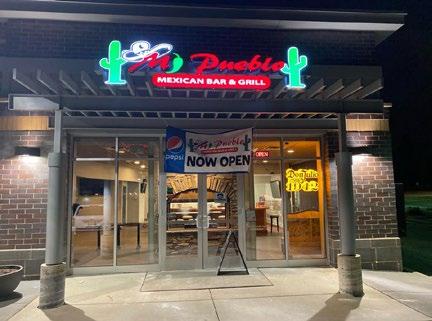schedule of events
July 30–Aug. 5
A series of free community events and programs to celebrate the unique cultures represented in Eden Prairie.

View full event details and register at edenprairie.org/PeopleFest
Sunday, July 30 3–7 p.m.
Staring Lake Amphitheatre
Exhibit booths, food trucks, a Human Library, art activities and live performances celebrating the many cultures that make Eden Prairie a wonderfully diverse community.
Confrmed Food Trucks
•Waffe Bar Food Truck
•Sambusa Express
•Pizza Karma
Ecuador Manta
Monday, July 31

7 p.m.
Staring Lake Amphitheatre
Heart and Soul Drumming
Tuesday, Aug. 1 10:30–11:15 a.m.
Staring Lake Amphitheatre
Tuesday, Aug. 1
Your neighborhood!
Midtown Global Market and Somali Museum Tour
Friday, Aug. 4
1:45 p.m.
Midtown Global Market
920 E. Lake St.
Minneapolis Somali Museum of Minnesota

1516 E. Lake St. #011, Minneapolis
Registration required
Movie in the Park: Wakanda Forever
Preshow entertainment: DJ Kool Akiem, Desdamona and See More Perspective
My Cup of Tea Class and Recipe Swap: Exploring Tea Traditions from Around the Globe

Wednesday, Aug. 2
6:30–8 p.m.
Eden Prairie High School
Registration required
Salsa del Soul
Preshow entertainment: Author reading with Habso Mohamud and People Shapes Kids Craft
Thursday, Aug. 3 5:45–8:30 p.m.
Staring Lake Amphitheatre
Friday, Aug. 4
7:30–10:30 p.m.
Staring Lake Amphitheatre
Interfaith Field Trip: A Tour of Three Local Faith Communities
Saturday, Aug. 5 11:30 a.m.–2:30 p.m.
•Sri Venkateswara (Balaji) Temple
•Masjid Al-Tawba
•Tu Viên Tây Phương Buddhist Meditation Center
Registration required
5:45–6:45 p.m.
Author reading and kids craft 7–8:30 p.m. Salsa del Soul performance
Story Stroll: We Laugh Alike/ Juntos Nos Reimos
Sunday, July 30–Saturday, Aug. 5
Library Hours
Eden Prairie Library
It is important to acknowledge that we are gathered upon the ancestral, traditional and contemporary homelands of the Dakóta. Through treaties the U.S. government seized Ojibwe and Dakóta land in Minnesota. Specifically, signing of the treaties of Traverse des Sioux and Mendota in 1851 opened land located to the west of Ȟaȟáwakpa/Wakpá Tháŋka (Mississippi River), allowing pioneers to settle in what is now Eden Prairie.



We acknowledge this land has a complex and layered history, and pay respect to the elders who have stewarded the land throughout the generations and continue to do so. We offer this statement as a step toward healing and make a commitment to learn the history of the land Eden Prairie is built on, to recognize, support, collaborate with and advocate for Indigenous People, and to consider the convergence of legacies that bring us to where we are today.

Cummins-Phipps-Grill House
13600 Pioneer Trail
John (JR) and Mattie Cummins established this farm in 1856 and lived in a log home until the present house was built in 1879. The home is a beautiful Chaska brick building with Greek Revival details.

The original property spanned 280 acres from the Minnesota River to Staring Lake. JR kept a horticultural journal throughout the 60 years they lived here, and his horticultural infuence was highly respected as he experimented with apple trees, nuts, fowers and fruit.
In 1908, the farm was sold to Edwin and Harriet Phipps, who purchased additional acreage, bringing the total property size to 385 acres. Edwin was known as “The Asparagus King of Hennepin County.”
Harriet purchased peony plants from the Minneapolis Farmers Market around 1920. Her large peony garden on the east side of the house is more than 100 years old and still enjoyed today! It is an important and protected feature of the property. Edwin and Harriet’s daughter Mildred Phipps married Martin “Pappy” Grill in 1934 and they purchased the farm. Pappy was Mildred’s schoolmate and had been a hired hand on the farm.
In 1943, Pappy sold the land to the American Aviation Corporation, which named it Flying Cloud Airport. It was later bought by the Metropolitan Airports Commission in 1948.
Pappy passed away in 1975 and Mildred sold the farm to the City of Eden Prairie in 1976. The Cummins-Phipps-Grill House was listed in the National Register of Historic Places in 1982 and is currently used by the Eden Prairie Historical Society.
Riley-Jacques Farmstead
9100 Riley Lake Road
The Riley-Jacques Farmstead was established by Frank Riley in 1855. The City of Eden Prairie purchased the land in 1990 to expand Riley Lake Park along the east side of the lake. The house, garage and barn are all part of the original farm. Today, the renovated barn is used for public events and is also available to rent for private functions.
challenge
Locate the “From Settlers to Suburbs” sign near the parking lot to learn what kind of farms settlers like the Warner family started establishing in the 1850s.
Dorenkemper House
9090 Riley Lake Road
The Dorenkemper House is one of the last remaining log-built homes in Eden Prairie. Constructed in the 1860s and originally located along Pioneer Trail at Settler’s Ridge, it was moved to the Riley-Jacques Farmstead in 2002 to save it from demolition.

The hewn log construction makes the house unique and historically signifcant. The house has been meticulously restored and is available for tours by appointment or during scheduled heritage events.
challenge
Read the sign in front of the house to determine the year Elizabeth Dorn Richard gave birth to daughter Irene in this home.
Consolidated School
8100 School Road
Built in the early 1920s, this Grand Mission-style building frst opened its doors to students in March 1924, with the frst senior class graduating in 1929.
The school was also an important cultural hub and community building, providing space for movies, voting, weddings and ironing clothes — the school was one of the frst buildings with electricity in Eden Prairie.


Today it houses the Eden Prairie Schools ISD 272 administrative offces. The building is also home to the district’s historic gym, which was a state-of-the-art facility at the time it was built as there were no supportive pillars in the middle of the court! This gym is still enjoyed daily by Little
Eagles Early Childhood & Preschool participants.
challenge
How many historical site markers are located on the south side of the building (near doors 4 and 5)?

Eden Prairie Cemetery
8810 Eden Prairie Road
The Eden Prairie Cemetery was established in 1865 and managed by the Eden Prairie Cemetery Association. Over the years, the cemetery board purchased additional land, expanding the cemetery to the property that exists today. In 2022, ownership of the cemetery was transferred from the cemetery board to the City of Eden Prairie.
Monroe Barker was a child-aged Civil War soldier and one of the frst Black residents of Eden Prairie. Monroe, also known as “Mun,” was listed as a farm laborer and lodger in Eden Prairie census rolls. He worked at Miller’s General Store until his death in 1942 at age 90.
Monroe is believed to have arrived in Eden Prairie around 1870 — the same time as emancipated slave Joseph Graham, who is also buried in this cemetery. Before Monroe died, he bought a granite tombstone and a plot in the Eden Prairie Cemetery.

challenge
Find Monroe Barker’s tombstone near the bottom of the hill. It is located near a family he was close to. What is the name on the family tombstone just to the left of his?

Pleasant Hill Cemetery
12390 Pioneer Trail
Pleasant Hill Cemetery was established in 1885 on land purchased by Jacob Wolf, located north of the Eden Prairie Presbyterian Church. The property overlooked the wide valley to the north, with Mill Creek at the base of the hill and Neill Lake in the distance. Before then, early Presbyterians used the old cemetery on Lyndale and 104th Street in Bloomington for burial. Once Pleasant Hill Cemetery was established, their ancestors were moved from Bloomington to Pleasant Hill.
The church building was removed in 1966 and the cemetery has been expanded twice. Ownership of the cemetery was transferred from the Pleasant Hill Cemetery Association to the City of Eden Prairie in 1987.
challenge
Notice the large number of Andersons buried in this cemetery. Locate Elizabeth Anderson’s large tombstone near the south side of the cemetery. She was born in 1792, in which year did she die?
The Anderson Clan — a large Scotch-Irish family — arrived in Eden Prairie in the 1850s. Mary Jane Hill Anderson, who married Elizabeth Anderson's son, Robert, wrote in her autobiography “Here in our cabin were our happiest days. We had a home of our very own; we were young and hopeful; and with our little family and life before us, and always work to do and the strength to do it, what more could we ask?”
Smith-Douglas-More House
8107 Eden Prairie Road
Lured by the rich farmlands, Sheldon and Mary Smith were among the early settlers in Eden Prairie, arriving from New York in their early 20s.
Their frst home was a cabin close to Round Lake. In 1877 they built an eclectic, red brick home with white scroll work reminiscent of the Queen Ann style. At that time, the home was in the center of town, which included a railroad depot, creamery, grain elevator, pickle factory and Miller’s General Store. Their young daughters, Amie and Etta, helped with the boarders who lived upstairs, and took care of the farm and kitchen garden. Both Sheldon and daughter Amie worked at the depot as telegraphers. Amie attended school in Minneapolis and Etta died at 16 from tuberculosis. Amie married David Frank Douglas, and their son Sheldon Douglas carried on the farm until 1948. Sheldon attended college in Pennsylvania and later served as chair of the Eden Prairie School Board.
The house was sold in 1952 to Earl and Helen More, who added electricity and beautiful hostas, peonies and lilacs around the homestead.

The City of Eden Prairie purchased the property from the Mores in 1982, and in 2001 the house was renovated to add a kitchen for commercial use as a coffee shop.
In 2006, Eden Prairie resident Ann Schuster and her family opened an independent coffee shop in the historic home. It is named Smith Coffee & Cafe to honor Sheldon and Mary Smith.
challenge
Find the “stained glass windows” in the parlor. Who created this beautiful work of art?
Richard T. Anderson Conservation Area
18700 Flying Cloud Drive
The Richard T. Anderson Conservation Area provides breathtaking views of the Minnesota River Valley.

challenge

Hike to the top of the bluff overlook and locate the River Valley History sign. How many people inhabited Tintonwan prior to 1853?
*This information comes from the "Dakota on the Minnesota" website (MNRiverHistory.org) and was reviewed by the Shakopee Mdewakanton Sioux Community.
This site has been settled since time immemorial, where indigenous people have fshed, hunted and harvested food; built houses, made tools and prepared meals; and raised families and buried those who passed on. Artifacts demonstrate great age, recent history and everything in between. The people who lived at this site were not alone. Networks of indigenous nations shared goods, languages and beliefs as they traveled along the Minnesota River Valley and far beyond. Objects found here demonstrate those interconnections and eras.*
























